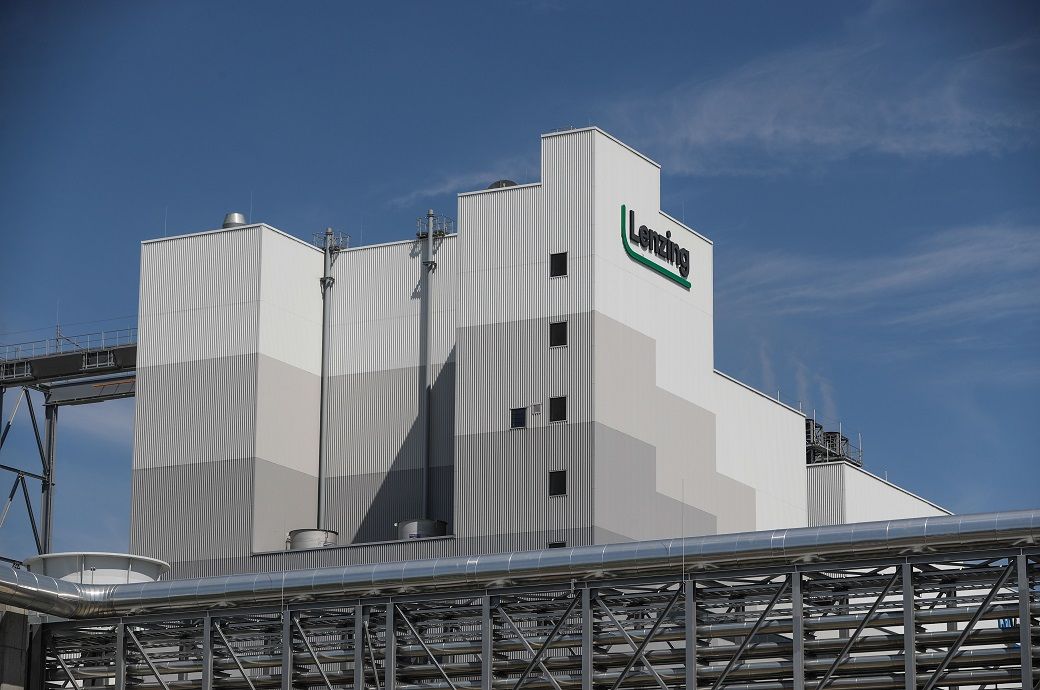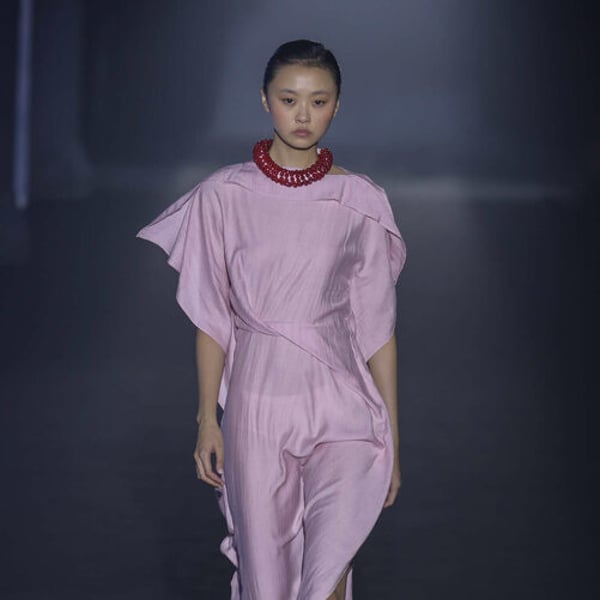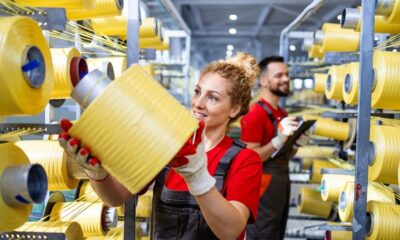Fashion
Austria’s Lenzing reports resilient results; outlook remains positive

In the first nine months of 2025, Lenzing AG recorded revenue growth and higher EBITDA, but a market-driven volatile third quarter. This performance reflects the effects of ongoing market volatility, tariffs and geopolitical uncertainties. Nevertheless, the medium to long-term outlook remains positive.
Lenzing AG’s revenue rose 0.7 per cent to €1.97 billion (~$2.27 billion) in the first nine months of 2025.
EBITDA grew 29.1 per cent to €340.4 million (~$391.5 million) amid market volatility.
The company is optimising operations, investing over €100 million (~$115 million) in Austrian sites, and reviewing its Indonesia plant to save €45 million (~$51.8 million) annually by 2027.
The revenue generated by Lenzing AG rose by 0.7 percent to EUR 1.97 bn (prior-year period: EUR 1.96 bn) in the first nine months. EBITDA grew by 29.1 percent to EUR 340.4 mn (prior-year period: EUR 263.7 mn), including effects from the sale of surplus emission allowances and the valuation of biological assets. The EBITDA margin improved to 17.3 percent (prior-year period: 13.5 percent). Earnings before interest and tax (EBIT) amounted to EUR 20.6 mn (prior-year period: EUR 38.3 mn), which corresponds to an EBIT margin of 1 percent (prior-year period: 2 percent). This result includes asset impairments of EUR 82.1 mn in Indonesia. Earnings before tax (EBT) amounted to EUR minus 98.7 mn (prior-year period: EUR minus 33.4 mn).
“We see these challenging times also as an opportunity. We are increasingly building on our strengths and are continuing to focus on what we excel at: strong brands, precise execution and bold innovation,” notes Rohit Aggarwal, CEO of Lenzing AG.
Strategic development
Lenzing AG pursues a holistically adapted strategy with a clear focus on value-generating growth. Key pillars of this strategy include enhancing operational efficiency, optimizing production sites, and targeting high-margin premium products such as TENCEL, VEOCEL, and LENZING ECOVERO. Additional growth potential is expected particularly in the fields of hygiene, packaging, filtration, as well as medical and industrial applications.
To sustainably secure this growth and strengthen long-term competitiveness, the company has initiated a strategic review of its production site in Indonesia. The planned measures – including adjustments to administrative functions – are expected to generate additional annual savings of approximately EUR 45 mn by the end of 2027. For the current reporting year, the Management Board anticipates cost savings exceeding EUR 180 mn. Furthermore, the company is investing over EUR 100 mn in its sites in Lenzing and Heiligenkreuz and aims to achieve holistic energy optimization of more than 5 percent across all production locations. Strategic options for the site in Indonesia are being evaluated, including a potential sale.
The Supervisory Board also made personnel decisions during the reporting period: The Managing Board mandate of Christian Skilich, Chief Pulp & Chief Technology Officer, was extended until May 2029. Mathias Breuer, currently Senior Vice President and responsible for the performance program, will become CFO from January 1, 2026, and succeed Nico Reiner, who is due to step down from his position at the end of 2025.
Solid financial position in a difficult environment
Thanks to its strong focus on cash management, Lenzing succeeded in leaving no doubt about its adequate liquidity position during the reporting period. As of September 30, 2025, the company held liquidity cushion of EUR 993 mn. The capital structure was strengthened by a EUR 500 mn hybrid bond and a EUR 545 mn syndicated financing facility. Net financial debt was reduced by 8.5 per cent to EUR 1.4 bn as of the reporting date. With total assets of EUR 4.80 bn, this corresponds to an adjusted equity ratio of 30.7% as of September 30, 2025.
Cash flow from operating activities amounted to EUR 284.6 mn (prior-year period: EUR 319.4 mn). Free cash flow was also positive at EUR 110.9 mn. (prior-year period: EUR 194.0 mn) Furthermore, unlevered free cash flow amounted to EUR 192.1 mn (prior-year period: EUR 228.6 mn).
Capital expenditure amounted to EUR 93.2 mn (prior-year period: EUR 93.3 mn).
Outlook
The global environment remains volatile. The International Monetary Fund (IMF) expects growth of 3.2 percent in 2025, but warns of trade conflicts and financial instability. Consumer sentiment is subdued, and higher tariff costs could further weigh on demand in 2026. Based on the business performance to date and the current market outlook, the Managing Board expects year-on-year growth in EBITDA in 2025. The actual business performance may nevertheless diverge from current expectations depending on geopolitical and economic factors as well as the cyclical nature of the industry. Any assessment of economic development is therefore subject to forecasting risks.
Note: The headline, insights, and image of this press release may have been refined by the Fibre2Fashion staff; the rest of the content remains unchanged.
Fibre2Fashion News Desk (HU)
Fashion
080 Barcelona Fashion to take place at Port Vell in April

Published
December 22, 2025
080 Barcelona Fashion has a new venue. The Catalan catwalk, which bid farewell last October to the Sant Pau Art Nouveau Site, will hold its next edition from April 14 to 17 at the Port of Barcelona, across the Port Vell and Marina Vela spaces.
The fashion platform, promoted by the Department of Business and Labour through the Catalan Government’s Trade, Crafts and Fashion Consortium, announced the move on Monday. With this change of setting, 080 Barcelona Fashion “kicks off a new chapter” that strengthens “the link between fashion and the city, with the sea as a global connector,” it said in a statement.
After years cementing its role as a showcase for emerging talent and with a clear and growing international outlook, 080 Barcelona Fashion aims to open up further to the city and position itself as “a megaphone for creativity.”
“This boost consolidates Catalonia and Barcelona as leaders in the fashion world, reinforcing their role as a creative and innovative hub, and with a clear international outlook,” the platform emphasised in a statement.
Its current director, Marta Coca, outlined the essence of the new location in October: “We want a completely different style to the recent editions, where modernism has taken centre stage. We are looking for a location that, while different, also defines Barcelona.”
The 37th edition of the event will look out to the sea from one of the city’s icons and attractions. The cycle beginning in April is aligned with the “Fashion Plan 2025-2030” promoted by Barcelona City Council, which made its debut as an investor in the event last October with a contribution of €150,000 (from a total budget of €2.15 million). The plan aims to “integrate fashion into the cultural, creative and economic map of the city and position Barcelona as a fashion capital.”
At its most recent edition at the Sant Pau Art Nouveau Site, 080 Barcelona Fashion welcomed more than 11,000 attendees and featured 24 brands, including labels such as Moisés Nieto, Acromatyx, Guillermina Baeza, Custo Barcelona and Carlota Barrera. It was an edition marked by new formats and synergies with public and private platforms in the sector.
This article is an automatic translation.
Click here to read the original article.
Copyright © 2025 FashionNetwork.com All rights reserved.
Fashion
Right wing urges boycott of iconic Brazilian flip-flops
By
AFP
Published
December 22, 2025
Prominent figures on Brazil’s right wing are calling for a boycott of Havaianas, the iconic Brazilian flip-flop sandals, over an ad seen as taking sides ahead of next year’s presidential elections.
In a video posted on the brand’s social media accounts, actress Fernanda Torres urges the public “not to start 2026 on the right foot,” but “on both feet.”
Torres, a supporter of the Brazilian left, was the lead actress in the Brazilian film “Ainda Estou Aqui” (“I’m Still Here”), which won the Oscar for Best Foreign Language Film this year.
The advertisement has sparked outrage in conservative circles.
Eduardo Bolsonaro, one of the sons of far-right former president Jair Bolsonaro — who is serving a 27-year prison sentence for an attempted coup after losing the last election — took to Instagram on Sunday to register his disgust.
In a video, he throws a pair of the flip-flops, recognizable from their straps adorned with the Brazilian flag, into the trash.
“Havaianas used to be a national symbol. I’ve seen many foreigners wearing this Brazilian flag on their feet… but I’m sorry, I’m going to throw these flip-flops in the trash,” says the US-based, former Brazilian lawmaker.
Conservative congressman Rodrigo Valadares posted on X: “Havaianas has chosen its side. The RIGHT has opted for a boycott.”
“My feet are burning on the asphalt, but Havaianas, never again,” right-wing influencer Thiago Asmar posted Monday on Instagram, where he has more than two million followers.
Havaianas are among the world’s best-selling sandals. The Alpargatas group, which owns the brand, employs 10,000 people and sold 226.6 million pairs of flip-flops in 2024, mostly in Brazil, according to its LinkedIn page.
The company has not responded to AFP requests for comment.
Left-wing congresswoman Duda Salabert denounced the reactions from the right as “idiotic attacks,” saying calls for a boycott threatens jobs in Minas Gerais, the southeastern state she represents, where one of the brand’s factories is located.
Torres won the Golden Globe for Best Actress for “I’m Still Here,” which recounts the years of the military dictatorship in Brazil, a period often evoked with nostalgia by Bolsonaro’s supporters.
South America’s largest nation is set to hold general elections in October 2026. Leftist President Luiz Inacio Lula da Silva, who defeated Bolsonaro in 2022, has said he plans to run for a fourth term.
Copyright © 2025 AFP. All rights reserved. All information displayed in this section (dispatches, photographs, logos) are protected by intellectual property rights owned by Agence France-Presse. As a consequence you may not copy, reproduce, modify, transmit, publish, display or in any way commercially exploit any of the contents of this section without the prior written consent of Agence France-Presses.
Fashion
eBay, Vestiaire Collective, H&M’s Sellpy among Europe’s top 10 sustainable re-commerce marketplaces

Published
December 22, 2025
French refurbished tech e-tailer Back Market is Europe’s top-ranked sustainable resale platform, according to Cross-border Commerce Europe (CCE). Three fashion resale specialists, eBay, Vestiaire Collective and H&M’s Sellpy, were among the ranking’s top-10 platforms, with Vinted in 11th place.
The CCE ranking is based on an analysis of the various players’ CSR pledges, cross-referencing the share of their business that falls strictly in the sustainability category with a weighted audit of over 75 sector certifications (like B-Corp and Fashion Pact). Besides certifications, the CCE methodology also assessed the business models, putting a premium on circularity initiatives (like resale and repair) and the presence of alternative services such as product rental, customisation, on-demand production, etc.
Europe’s top-ranked sustainable marketplace was French refurbished tech e-tailer Back Market, ahead of Etsy (USA), OLX (the Netherlands) and Refurbed (Austria). eBay came fifth, ahead of British used photo and video equipment e-tailer MPB.
Vestiaire Collective, the French specialist in second-hand premium and luxury fashion, ranked seventh, followed by Sellpy (owned by Swedish group H&M), by British used tech specialist CeX, and by another French high-end pre-owned fashion marketplace, Collector Square. Vinted was ranked 11th.
Among the factors negatively affecting CCE’s sustainability rating are the carbon impact associated with air freight, high return rates, and a business model based on fast fashion. China-based businesses raised major ethical concerns in terms of human rights compliance, while lack of transparency on traceability was another factor negatively affecting a marketplace’s ranking.
“The re-commerce market is projected to account for 7.4% to 7.8% of the fashion and beauty industry by 2026, up from 6.9% in 2025,” stated CCE, adding that cross-border e-commerce generates 70% of the re-commerce sector’s sales volume.
In 2025, CCE said that marketplaces accounted for 74% of Europe’s online re-commerce GMV (which was up by 18%), generating a revenue of €90 billion out of a total of €121 billion.
Copyright © 2025 FashionNetwork.com All rights reserved.
-

 Business1 week ago
Business1 week agoStudying Abroad Is Costly, But Not Impossible: Experts On Smarter Financial Planning
-

 Business1 week ago
Business1 week agoKSE-100 index gains 876 points amid cut in policy rate | The Express Tribune
-

 Fashion5 days ago
Fashion5 days agoIndonesia’s thrift surge fuels waste and textile industry woes
-

 Sports1 week ago
Sports1 week agoJets defensive lineman rips NFL officials after ejection vs Jaguars
-

 Business5 days ago
Business5 days agoBP names new boss as current CEO leaves after less than two years
-

 Tech1 week ago
Tech1 week agoFor the First Time, AI Analyzes Language as Well as a Human Expert
-

 Entertainment1 week ago
Entertainment1 week agoPrince Harry, Meghan Markle’s 2025 Christmas card: A shift in strategy
-

 Tech5 days ago
Tech5 days agoT-Mobile Business Internet and Phone Deals


















